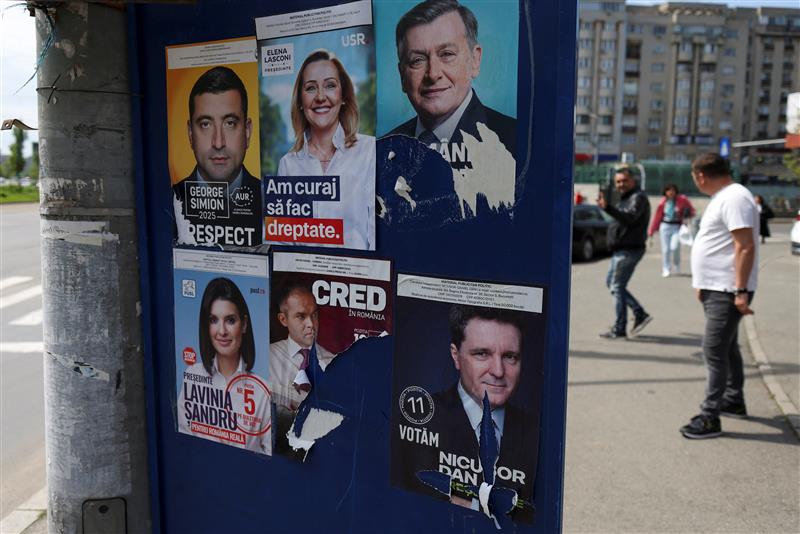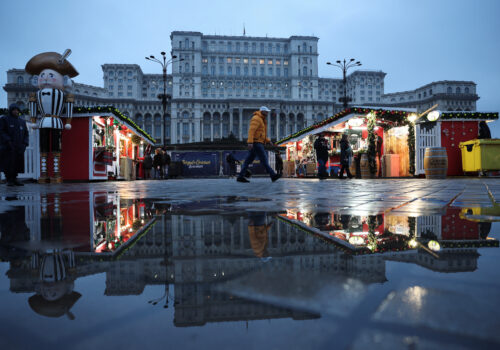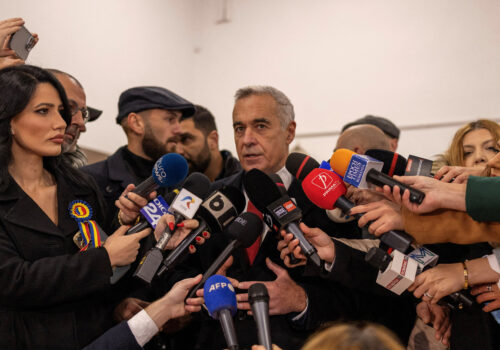It’s been a long road to this election for Romania. The country went to the polls to elect a new parliament on December 1, 2024, and a new president just five days later. While the parliamentary elections were carried out smoothly, irregularities in the presidential campaign sparked concern after far-right candidate Călin Georgescu climbed from an expected support of around 5 percent to 23 percent of the vote. Following a Romanian government investigation alleging that external actors had financed and used social media to tilt the election in Georgescu’s favor, the second round was canceled entirely and a second attempt of the first round was rescheduled for May 4. With the rescheduled election starting from scratch, the Romanian Constitutional Court decided to ban Georgescu from running again in May.
Sunday’s first round saw nationalist candidate George Simion win more than 40 percent of the vote, putting him in first place heading into the runoff. Following Simion’s victory, Prime Minister Marcel Ciolacu resigned, triggering the National Bank of Romania to intervene and prevent the currency from weakening and highlighting an emerging period of instability.
Ahead of the second round on May 18, our experts are breaking down the race and its potential impacts on Romania’s foreign policy.
What happened in the first round on May 4?
Romania, like many European Union (EU) members, is undergoing a wave of populist backlash against established parties and elites, including the traditional ruling parties—the Social Democratic Party (PSD), National Liberal Party (PNL), and Democratic Alliance of Hungarians in Romania (UDMR)—which have formed the basis of governance over the past thirty-five years. Two parties (PSD and PNL) have been in a coalition since 2021, renewed this past December after the pro-Western parties led the vote and, together with a party of the ethnic-Hungarian minority, secured a slim majority of 53 percent to form a government.
In Romania this backlash has taken the form of populist nationalism, led primarily by a very active diaspora of over three million people who get much of their information via social media. Last year’s first round of elections saw the previously obscure Georgescu ride a TikTok campaign to first place. He proved an untenable figure due to his controversial background, including praising fascist leaders, not declaring campaign spending, and the use of a security detail comprised of mercenary/former military elements who were accused of inciting social unrest. This time around, the winner was Simion with 40 percent of the vote, running on a similar far-right populist nationalist platform—pro-US and pro-NATO, but with anti-EU and pro-Russian rhetoric—and also capturing the Georgescu electorate and message. Second place went to Nicusor Dan, the mayor of Bucharest, a pro-EU and reformist candidate who received 21 percent.
Simion has sought to align himself with the Make America Great Again (MAGA) movement in the United States, making connections with influencers and media and showing up everywhere from the Conservative Political Action Conference to Steve Bannon’s podcast. Meanwhile, former Prime Minister Victor Ponta (in fourth place at 15 percent) also sought to align with MAGA by openly associating himself with US President Donald Trump and running a “Romania First” campaign. His electorate could be decisive for the final round.
These voters are driven by a combination of ideological support for nationalist political rhetoric and a strong anti-establishment streak that Romanians at home and abroad have twice brought to victory in parliamentary elections, with issues such as the lack of economic opportunities and shortcomings in the education and health systems moving the barometer of discontent. As such, no traditional party has made it into the second round in two consecutive presidential elections (December 2024 and May 2025).
—Alex Serban is a nonresident senior fellow in the Transatlantic Security Initiative in the Atlantic Council’s Scowcroft Center for Strategy and Security, based in Bucharest.
Simion’s strong result, like Georgescu’s, seems to have been a protest vote against the political establishment of centrist parties that has governed the country for many years. Romania’s economy has been growing steadily, due in part to the country’s EU membership, but public aggravation with corruption, problems with government services such as health and housing, and a simple desire for change have given rightist populists the edge. The candidate of the ruling political coalition, Crin Antonescu, came in third, behind Dan, who has positioned himself as a good governance reform centrist. Georgescu supported Simion. As a result of Antonescu’s poor showing that suggests popular rejection of the ruling coalition, Ciolacu has resigned, and his center-left Social Democratic Party is reportedly set to leave the coalition. Romania’s interim President Ilie Bolojan, in office only since February when his predecessor resigned in the wake of the annulled presidential vote, nominated Interior Minister Catalin Predoiu as a caretaker prime minister.
Simion is the favorite in the runoff but not a shoo-in. While Simion’s vote total was impressive, it is roughly matched by the combined totals of Dan and Antonescu. The second round could go either way as voters chose between two opposition politicians.
—Daniel Fried is the Atlantic Council’s Weiser Family Distinguished Fellow and a former US ambassador to Poland.
How do the outcomes set the stage for the second round?
Simion received 41 percent of the vote and Ponta 13 percent, which is a majority for the populist candidates, leading to speculation that Simion is nearly guaranteed to win the second round. Both candidates used pro-US messages, with Simion positioned as a Trump-like figure and supported by “Patriots for Europe” parties (including those of Italian Prime Minister Giorgia Meloni and former Polish Prime Minister Mateusz Morawiecki).
There are, however, a few signals that the race may be becoming much closer than the first round would indicate. With the elimination of Antonescu, the establishment parties’ votes are up for grabs as well as millions of undecided voters who may not have participated in the first round—the likes of whom helped swing the presidential elections for Traian Basescu in 2004 and Klaus Iohannis in 2019.
Instead, there is Dan, an independent who was twice elected mayor of Bucharest on a platform of anti-corruption and against political parties, who has fought back allegations of ties to controversial pro-Russian business and intelligence services.
So the vote is becoming a referendum on Simion and his views about Europe, as well as the candidates’ views on Russia. It is not clear if the anti-establishment vote will translate into support for Simion in the second round, since there is not a clear establishment choice on the ballot to vote against. Further complicating matters, a larger turnout is expected on May 18.
Another consideration is Romania’s history of massive urban and diaspora turnouts in second rounds when emotional issues drive dormant voters, as occurred in 2000 against Vadim Tudor’s extreme right candidacy under the Greater Romania Party and in 2014 against PSD’s attempts to constrain voting by the diaspora. This latter phenomenon saw Iohannis emerge from second place in the first round, where his 30 percent of the vote trailed Ponta’s 40 percent, to win the second round, 54 percent to 46 percent. Despite a poor organization and low charisma, Iohannis won the second round by mobilizing an additional four million votes, mostly from increased urban voting, driven largely by anti-PSD sentiment.
This time around, Dan held a sizeable lead over Simion in Bucharest in first-round voting, so there is the potential for Dan to turn out new voters in urban areas. Simion has a greater share of high-propensity voters. If turnout is similar to the first round, then he is the likely winner, but Dan has a higher ceiling and is better positioned to win if there is high turnout. Dan is hoping to take turnout from around 47 percent in the first round to 65 percent, as he aims to make the final round about Romania’s strategic orientation. Dan essentially wants to ask Romanians to choose between a pro-Western direction vs. an anti-Western one.
—Alex Serban
How might the second-round outcome impact Romania’s foreign policy?
Dan seems to be solidly pro-Western and pro-EU. His victory could give a second wind to the pro-democracy forces (of various stripes) that have led Romania since its chaotic, violent, but successful overthrow of communism in 1989 and drove hard toward the country’s successful accessions to NATO and the European Union.
Simion’s strategic orientation is less clear. He and his Alliance for the Union of Romanians (AUR) party have been reaching out the MAGA movement in the United States. Simion has declared himself pro-US and has styled himself as a Trump-like “Romania First” candidate, conservative on cultural issues, skeptical of the EU and its liberal political culture, and reserved about support for Ukraine (including on the basis of Ukraine’s alleged mistreatment of its Romanian minority).
Whether as president Simion would push a strategic realignment away from the EU and NATO is not clear. Cultural conservativism plays well in Romania. There may be a political market in Romania for a nationalist defense of Romanian communities in Ukraine. As president, Simion would probably push both these ideas. However, Romania receives a lot of funding from the EU, a disincentive for any Romanian leader to go further than performative swipes at Brussels. A Romanian strategic turn toward Moscow would face strong obstacles: Romania’s history has left bitter memories of Russian imperialism and Soviet domination (and dismemberment) of Romania. Fears of being abandoned by the United States in the face of Kremlin ambitions seem present even among some in Simion’s AUR party.
Simion could of course turn toward Moscow, much as has his fellow rightist, Hungarian Prime Minister Viktor Orbán. An alignment with Orbán, however, whose Hungarian nationalism comes partly at Romania’s expense, might not be a political winner in Romania. Alternatively, Simion could draw from the successful tactics of Meloni, who is solidly rightist and well-tied to MAGA but also Atlanticist and pro-Ukrainian.
In that case, a President Simion would continue support for Ukraine but combine it with an effort to push issues related to Ukraine’s Romanian minority. Should the Trump administration finally set a policy of support for Ukraine—either in the form of a sustainable negotiated cease-fire or in response to continued Kremlin stonewalling—Romania, even with a Simion presidency, would be more likely to back this.
In short, a Dan presidency is more likely to be better integrated with the European mainstream and certainly a good strategic partner for the United States; a Simion presidency has its risks, especially if Simion goes full anti-Ukraine and pro-Kremlin. But it could also land in a rougher version of pro-Western and, potentially, even use its ties with MAGA to urge the Trump administration to hold the line against Kremlin aggression.
—Daniel Fried
A Simion presidency would pivot Romanian foreign policy toward “Romania First” and Euroskepticism, emulating Trump’s MAGA model. His anti-EU stance, viewing Russian President Vladimir Putin as non-threatening, could weaken ties with Brussels, risking the isolation of Romania akin to Orbán’s Hungary, including for EU funding. Despite repeatedly praising NATO’s role on the eastern flank, Simion’s opposition to Ukraine aid and call to “stop the war” may strain NATO cohesion and Romania’s role in the Black Sea. His pro-Americanism seeks stronger bilateral relations, but it may falter if US policy demands support for Ukraine and if the Department of Homeland Security’s recent suspension of Romania’s participation in the visa waiver program remains part of the Trump administration’s anti-immigration agenda.
A Dan presidency would solidify Romania’s pro-Western alignment. Leading a coalition of center-right, center-left, Hungarian, and progressive parties will consolidate Dan’s pro-EU agenda and strengthen ties with Brussels, ensuring Romania’s influence in EU decision making. His commitment to NATO and Ukraine aid would maintain Romania’s strategic role, supporting US-led initiatives and regional stability. Dan’s anti-corruption focus could enhance Romania’s credibility in Western institutions, attracting EU funds and investments. However, his reliance on an urban base may mean he struggles to unify rural voters, requiring deft coalition-building to counter nationalist sentiment. Dan’s victory would reinforce Romania’s role as a reliable NATO and EU partner, prioritizing democratic reforms and transatlantic unity.
—Alex Serban
Are there concerns about the election’s integrity after the first round?
Despite the absence of major public or press focus on election integrity, some security concerns persist from the first round.
Russian hacker group DDOSIA/NoName057 launched cyberattacks targeting government and candidate websites (e.g., Antonescu and Dan), though Romania’s Cybersecurity Directorate mitigated disruptions.
Simion alleged fraud involving deceased voters on electoral rolls, but these claims lack substantiation and have not gained traction in mainstream media or among the public.
Overall, there has been no significant evidence of systemic fraud or foreign manipulation, and—in contrast with the more personality-focused 2024 election—the local population appears focused on candidate platforms, with Simion’s nationalism and Dan’s pro-EU stance dominating the discourse.
Press coverage has emphasized electoral outcomes over integrity issues, reflecting confidence in institutional oversight following the reforms put in place following the December 2024 vote. However, ongoing campaign finance probes and disinformation risks warrant vigilance for the May 18 runoff to maintain Romania’s electoral stability.
—Alex Serban
Related reading

The Europe Center promotes leadership, strategies, and analysis to ensure a strong, ambitious, and forward-looking transatlantic relationship.



